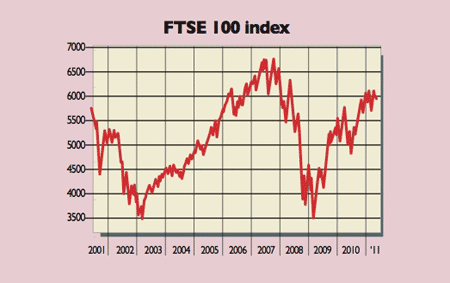Stocks are stuck in a rut
Stocks on both sides of the Atlantic are stuck in a rut, while some predict another dip on the horizon. Meanwhile, bonds offer little cheer as ten-year yields slide in Europe and America, and government and private debts are set to stunt growth for the next few years.
Sell in May and go away' has been a good bet so far this year. The FTSE All-World Index fell around 4% last month and most major markets slid from their post-crisis highs. The end of the US Federal Reserve's money printing programme in June, which has buoyed all risky assets, is denting confidence, as is the eurozone debt crisis, says Michael Mackenzie in the Financial Times. Economic data have been "faltering" on both sides of the Atlantic, while emerging economies are raising interest rates to fight inflation.
Most major stockmarkets are still only slightly below their post-crisis highs, but government-bond investors, at least, seem severely rattled by the growth outlook. Ten-year yields have slid (reflecting rising prices) by 14%-15% in Germany, the US and Britain in just eight weeks. Bonds are saying that "the industrialised economies are going to see very little growth this year and probably not much growth for a few years to come", says Morgan Stanley's Anthony O' Brien.
Working off high private and government debt loads is likely to keep a lid on growth over the next few years, while history suggests that the next downturn in the developed world's business cycle "could be just around the corner", says Richard Milne in the FT. A study of the length of US business cycles since 1854 by Deutsche Bank's Jim Reid suggests that, based on the mean average length of these cycles,the next recession is due in August 2012. Take the median length of the cycles as a yardstick, however, and the start date jumps to August 2011.
MoneyWeek
Subscribe to MoneyWeek today and get your first six magazine issues absolutely FREE

Sign up to Money Morning
Don't miss the latest investment and personal finances news, market analysis, plus money-saving tips with our free twice-daily newsletter
Don't miss the latest investment and personal finances news, market analysis, plus money-saving tips with our free twice-daily newsletter

Another worry is that profit margins, which tend to revert to the long-term average, are still near historic highs in the Western world and analysts expect them to rise even further. So there is ample scope for earnings to disappoint, says Morgan Stanley's Gerard Minack. Stocks, too, are no longer cheap.
While the near-term outlook is discouraging, so is the big picture. US and UK stocks have gone nowhere for ten years, although there have been major ups and downs in this period. Now another dip is threatening to materialise, and a long-term bull run seems unlikely to begin until we have fully recovered from the post-credit-bubble hangover. This sideways market, says Jupiter Asset Management's Edward Bonham Carter, "has the potential to continue for longer than people may imagine".
The big picture: US growth not as good as it looks

Official figures often overstate the US economy's strength, says The Economist. Kevin Daly of Goldman Sachs estimates that, in the ten years to 2008, America's quarterly GDP growth figure was, on average, revised down by an annualised 0.5% between the first and final published estimates. The final figure often only emerges years later. Eurozone quarterly GDP figures were revised up by an average of 0.3% in that period. It was a similar story in Britain.
Get the latest financial news, insights and expert analysis from our award-winning MoneyWeek team, to help you understand what really matters when it comes to your finances.
MoneyWeek is written by a team of experienced and award-winning journalists, plus expert columnists. As well as daily digital news and features, MoneyWeek also publishes a weekly magazine, covering investing and personal finance. From share tips, pensions, gold to practical investment tips - we provide a round-up to help you make money and keep it.
-
 How gifting money this Christmas could lower your inheritance tax bill
How gifting money this Christmas could lower your inheritance tax billCash is an easy and quick present to give over Christmas – and it could protect some of your estate from the taxman down the line
-
 £100 contactless card limit to be lifted
£100 contactless card limit to be liftedConsumers will be able to set their own contactless limits from March 2026, under new rules from the Financial Conduct Authority

